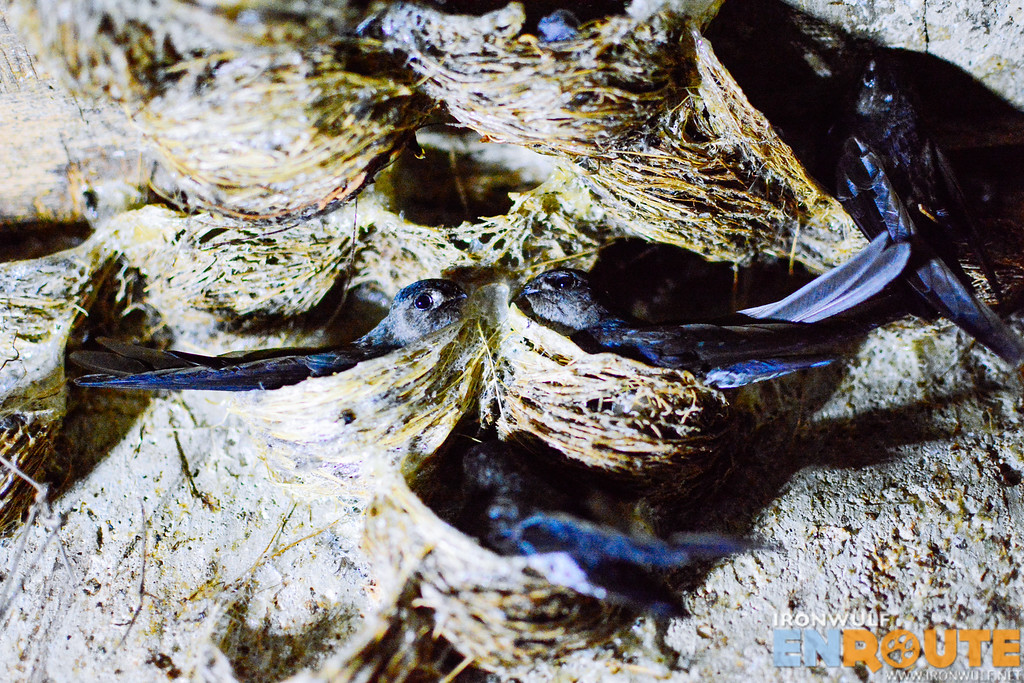At the towering limestone cliff walls in Palawan or high up the ceiling in the deep cave chambers in Cagayan, I have seen harvesters risk their lives climbing sharp walls or hanging by the ceiling supported only by a rope in order to gather the swiftlet bird nest. The swiftlets locally known as the Balinsasayaw uses their saliva to build their nest. When the nest is submerged in water, it becomes gelatinous and has been used as an exotic ingredient by the Chinese in their Bird’s Nest soup for over 400 years. People risk their lives for this as this lucrative nest cost about US$2000 per kilo. A house however in San Pascual, Burias Island in Masbate has another story. There is a Balinsasayaw House where an estimated 80,000 swiftlets lives right under their basement.

The Balinsasayaw House
“Nag umpisa yan dalawa lang silang balinsasayaw na gumagawa ng pugad nung ginagawa namin yung garahe. Tas ewan ko ba, parang nagtawag sila tas makalipas isang buwan dumami sila (It only started with two swiftlets building a nest when we were building the garage. I dunno if they called up their other bird friends because after a month there were lots of them!)”fondly recalled Mr Eduardo Espares, the owner of the house.
It was way back in 1991 when they built the house. A friend of theirs dropped by and told them the swiftlets were probably attracted and felt comfortable with the cave-like temperature of their basement. They eventually decided to give up the basement for the birds. They punched holes on the wall so they can freely come and go as they please.

The Basement
[pullquote]“Binibilang namin yung nest isa isa kaya nakuha namin yung number na 80,000 (We count the nest one-by-one thats how we came up with the number of 80,000)” said sir Eduardo.[/pullquote]
Mr. Eduardo Espares led us into the house. There was a stand for caps/hats already to prevent bird droppings to fall on the hair. The door to the basement was through their bedroom. From there I could already smell the pungent air coming through the door. It became stronger as we went down the stairs through the dark room almost burning through the eyes like ammonia. Once our sight got used to the darkness, eventually we became immune to the smell. It was fascinating to see all these swiftlets clinging through the walls. They seem to have gotten used to humans as well as they don’t fly away when we approach. For the first time, I could see them closely. Some nests also have eggs.
Looking at the room I’m not sure if it would reach that number but it is really fascinating. Other people would risk lives to gather these nests but here they are, they just need to go down the basement to get them. But sir Eduardo was also quick to say that he needs to regulate people coming in. The house is still their family home. Once, he allowed a couple of people to pick some nests and left them for a while. When he came back all the nests were gone. He was worried that the birds might leave but eventually, they restarted building their nest again.
The bird’s nest was not only the significant item in the basement but the excrement as well which is also used as fertilizer. With this, the local government is working closely with the family to keep the place and regulate visitors to avoid any who would take advantage of them. They consider the presence of these thousands of swiftlets as a blessing and would also like to share this wonder with the visitors.
The Balinsasayaw House can be reached via a 5-minute tricycle ride from town. Coordinate with San Pascual Tourism Office to schedule a visit. Contact 09199112270.

How to go to San Pascual, Burias Island, Masbate
The advantage of San Pascual, Burias Island from the rest of Masbate is its easy accessibility to Naga City, Camarines Sur.
- Manila to Naga City by Bus: Ride any Naga City bound bus in Cubao Terminal. Plenty of choices from Philtranco, DLTB, Isarog Lines, etc). In Pasay, there’s Philtranco and DLTB. Travel time is 8–9 hours with fares starting from Php 700 to 1100.
- Manila to Naga City by Plane: There are daily flights to Naga City via Cebu Pacific or Philippine Airlines. Travel time is 45 minutes from Manila. Naga City Airport is near the town of Pili.
- Naga City to Pasacao Port: Make your way to North Bound Terminal and take a jeep or VAN heading to Pasacao. Travel time is 45 minutes to an hour. From Pasacao, hire a trike to take you to the port.
- From Pasacao Port to San Pascual: There are several boats that leave Pasacao Port for San Pascual daily usually from 7:00 am, 10:00 am, and 2:00 pm. Travel time is 2 hours and a fare of Php 150. From San Pascual to Pasacao Port, there are boats that leave at 5:30 am, 8:00 am, and 9:20 am.





Ferdz Decena is an award-winning travel photographer, writer and blogger. His works has found print in publications such as Singapore Airlines’s Silver Kris, Philippine Airlines’ Mabuhay, Cebu Pacific’s Smile and Seair InFlight. He has also lent his expertise to various organizations like the Oceana Philippines, Lopez Group Foundation, Save the Children and World Vision, contributing quality images for their marketing materials.
